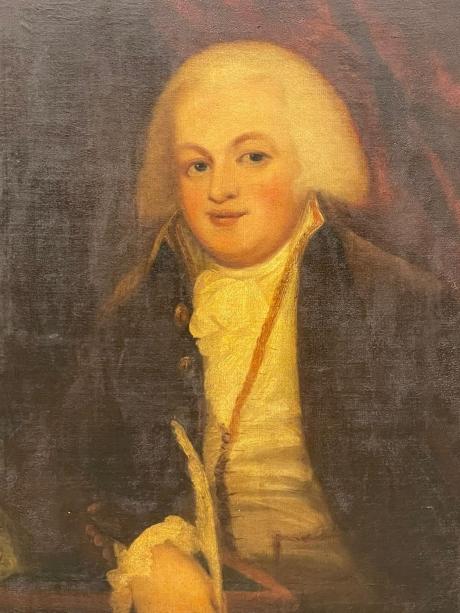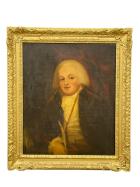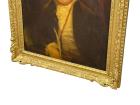Daniel PRING was the second child of Daniel PRING and Mary Chard, and was known by the epithet ‘the Lawyer’. He was sent off to Law School and then settled and practiced in Exeter, where he became highly esteemed and exercised the Office of Under Sheriff. By 1725 he had acquired several Exeter properties in the High Street as well as St. Petrock amongst which was his new residence and a further Tenements in the Parishes of; Holy Trinity, St. Stephen, St. Martyn and St. Mary Major. He also acquired number of substantial Messuages in Awliscombe and Honiton. A portrait of Daniel PRING (artist unknown) is held by the Taunton PRINGs. He is described as distinguished in his Lawyers attire of White Wig, Velvet Coat and white waist-coat which is bordered by edging of gold. He is at his desk with goose quill in his right hand with documents of sorts at his elbow emphasising his clerkly skills. In the family Journal it is described in his frequent visits between Exeter and Awliscombe that the ‘trappings of his horse’ carried the ‘Family Crest’. This saddle cloth, that was kept by the family for sometime showed a ‘Spread Eagle’, worked in silver cord.
Daniel PRING was baptised; 24th Sept. 1696 Awliscombe, he died 22nd Nov.1762 and is buried in St. Petrock, Exeter. Daniel PRING firstly married a Widow, Jane Butter of Exeter, 31 Aug. 1723. The marriage lasted 4 years, Jane died Exeter, 1727. Jane Butter inherited her husbands bookshop in Exeter High street, near St. Martins Lane. She continued to run the bookshop after her marriage to Daniel.
Daniel PRING next married Joanna Taunton of Ipplepen, Devon. The marriage took place in Exeter, 13th December 1731. Joanna Taunton was a Widow she previously married Phillip Neyle at Lamerton, Devon 4th September 1727. Phillip Neyle died 1731 (before), Probate was 1737 Kingskerwell, Devon. Joanna's brother was the Rev. William Taunton (1723bfr. – 30 Dec 1783 Ipplepen) was Vicar at Ipplepen until his death in 1783. The Rev. William Taunton was a benficiary in Daniel The Lawyers Will.
Joanna Taunton is descended from the Oxford Taunton’s and is related to Sir William Elias Taunton (1773-1835) through her cousin Rev. Elias Taunton of Sowton, Devon. There was no Issue to the marriage of Daniel PRING and Joanna Taunton. Joanna died 19 Apr 1774 and is buried at St. Petrock, Exeter. Daniels Will was a complex of over 10 pages. Daniels younger brother John PRING (1709-1792) ended up as Sole Executor and Residuary Legatee. There were some specific beneficiaries, however the Ivedon Estates were to apportioned to Daniel PRINGs three Nephews (sons of his brother John) ........
(i). Daniel PRING (1745-1791) who would remain at Awliscombe with Ivedon, then to the 2nd son;
(ii). John PRING (1750-1840) who went to live in Crediton and to the 3rd son;
(iii). William PRING (1753 - 1821) who went to live in Taunton, Somerset.
So the Ancient Manor of Ivedon (which had been added to considerably by Daniel PRING the Lawyer) was once again divided into 3 portions reminisent of the occurrences all those centuries before under William de Ivedon.
Ivedon has been the seat of the PRING family since 1550c. Ivedon was; ‘a portion’ of the Ancient Manor of Ivedon, granted by William the Conqueror to William de Ivedon after the Conquest. On the death of de Ivedon without a male issue it was divided into 1/3rd portions and devised equally to his 3 daughters. The portion called Ivedon passed to the de Stanton family on marriage to the daughter of de Ivedon, then by descent to Baldwin Malet and purchase by PRING (see Sources below). Ivedon House on the side of St. Cyres Hill, remains to this day.
Tracy was the seat of Sir William de Tracy, the Ancient Manor of Tracy. Sir William de Tracy called his portion (of the de Ivedon Manor) 'Tracy' after himself. This portion descended through marriage to the Chard Family who occupied Tracy/Traceyhayes since the 1400c.
Both Thomas Chard the Abbot of Forde, and Mary Chard, (who married Daniel PRING) were born at Tracy. Tracy House by 1950 had fallen into a state of poor repair, it was demolished in 2003, the gardens remain and are open to the public.
Richard Cosway RA (5 November 1742 – 4 July 1821) was a leading English portrait painter of the Georgian and Regency era, noted for his miniatures. He was a contemporary of John Smart, George Engleheart, William Wood, and Richard Crosse. He befriended fellow Free-masons and Swedenborgians William Blake and Chevalier d'Éon. His wife was the Italian-born painter Maria Cosway, a close friend of Thomas Jefferson.
Richard Cosway was born in Tiverton, Devon, the son of a schoolmaster. He was initially educated at Blundell's School, where his father was master, but at the age of twelve he was allowed to travel to London to take lessons in painting. Soon after his arrival, in 1754, he won a prize from the Society of Arts. He studied briefly with Thomas Hudson, then with William Shipley, and by 1760 had established his own business. He exhibited his first works at the age of 20 in 1762 and was soon in demand.
He was one of the first group of associate members of the Royal Academy, elected in August 1770, and was elected a full member the following March, on the casting vote of the academy's president, Sir Joshua Reynolds. He is included in Johan Zoffany's group portrait of the members of the academy (begun in 1771); a late addition to the composition, he was painted on an extra strip of canvas, attached to the right-hand side of the painting.
He painted the future King George IV in 1780 and was appointed Painter to the Prince of Wales in 1785—the only time this title was ever awarded. His subjects included the Prince's first wife, Maria Anne Fitzherbert, and various English and French aristocrats, including Madame du Barry, mistress of King Louis XV of France.
Cosway's pupils included Andrew Plimer (1763–1837).
From 1995 to 1996, the National Portrait Gallery in London held an exhibition entitled Richard and Maria Cosway: Regency Artists of Taste and Fashion, with 250 works on display.
A SMUGGLING MACHINE or a Convenient Cos(au)way for a Man in Miniature. A 1782 etching satirising the relationship between Cosway and his wife. Published by Hannah Humphrey.
On 18 January 1781, Cosway married the Anglo-Italian artist Maria Hadfield. Maria was a composer, musician and authority on girls' education and was much admired by Thomas Jefferson, who wrote letters to her decrying her marriage to another man and kept an engraving made from one of Cosway's paintings of Maria at Monticello.
The Cosways' marriage is thought to be an arranged marriage of convenience, and not only due to his being 20 years her senior. Richard Cosway was an effeminate Macaroni with "a mincing, affected air" dressed in the height of fashion: "His small plain person was to be seen in all the public places clothed in a mulberry silk coated embroidered with scarlet strawberries, with a sword and bag and small three-cornered hat perched on the top of his powdered toupée." It was also said he was "well known as a libertine and commonly described as resembling a monkey."
In 1784, the Cosways moved into Schomberg House, Pall Mall, which became a fashionable salon for London society. They employed the former slave Ottobah Cugoano as a servant. In 1791 they moved to a larger house in Stratford Place. In 1821, after selling most of the treasures he had accumulated, he went to reside in Edgware Road.
In later life, Cosway also suffered from mental disorders and spent some time in various institutions. He died in London in 1821 and was buried at St Marylebone Parish Church. Sir John Soane bought more than 30 objects put up for sale at auction after Cosway's death.
Cosway's wife Maria survived him many years, and died in Italy in January 1838, in a school for girls which she had founded, and which she had attached to an important religious order devoted to the cause of female education, known as the Dame Inglesi. She had been created a baroness of the Empire on account of her devotion to female education by the emperor Francis I in 1834.





